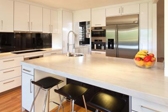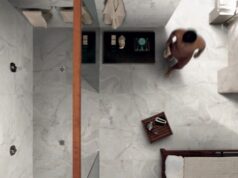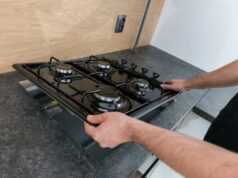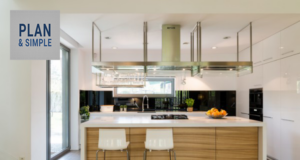
Find out what kitchen cabinets are made of, how they’re put together, what parts they involve, and what sorts of options you have when choosing cabinets for your kitchen.

What are cabinets?
A kitchen cabinet or carcass is a well-built wooden box used to provide storage in your kitchen. Cabinets in kitchens are generally divided into three functional categories:
- Base or floor cabinets: These sits on the floor, and support your benches and kitchen sink.
- Wall cabinets: These are affixed up on the wall in the kitchen, and typically contain cups, saucers, food products and cookbooks.
- Utility or full-height cabinet: These extend from floor to ceiling. Historically, these were intended as broom closets, but today are most often used as pantries.
Cabinets can either be frameless or face framed. Face framed cabinets feature a frame on the front of the cabinet which supports the cabinet, and to which the door is attached. These days, most kitchen cabinets are frameless, and the door attaches to the inside of the cabinet instead with a set of hinges.
If the cabinet is a wall or utility cabinet, it will have its own top. If the cabinet is inbuilt, the benchtop or countertop will act as the roof. Cabinets can also be cut or manufactured to accommodate appliances like your dishwasher, refrigerator, oven and microwave.
Cabinet materials
While timber’s still a popular and very attractive choice for cabinetry, many (if not most) cabinets these days are likely to be made from engineered wood products like particleboard or medium density fibreboard (MDF), finished with a layer of plastic laminate. These types of cabinets are typically cheaper than conventional wood cabinetry, offer a broader choice as far as aesthetic finishes go, and are sufficiently strong and moisture resistant.
Plastic and metal cabinets are also common, and can look fantastic.
Custom finished cabinets vs factory made cabinets
The cabinets you buy for your kitchen will normally either be custom finished cabinets (also known as bespoke, built-in or fitted) or factory made cabinets. Most factory made cabinets are built to look as if they are hand-made. Artisans still exist; the Victorian Cabinet Makers Association is an example, but more and more people are choosing the ease and cost of ready-made machined cabinets that have a hand-made feel.
If you’re looking for custom cabinets, costs will vary depending on the level of customisation and specification, and as you’d expect, exclusive designs involve larger costs. If the materials are common but the design is different, then the job is considered to be semi-custom and is cheaper. The components of a semi-custom job are normally sourced from large scale component suppliers. They can be altered to suit the layout of your kitchen.
Factory cabinets, by contrast, normally come in standard sizes, material choices and finishes. These types of cabinets are the cheap and readily available, but the styles are somewhat limited.
How are cabinets made?
The different faces of timber cabinets are normally fitted together using what’s known as dado, rabbet and groove joints. These shallow cuts in the side panels of the cabinets allow the shelves and backing of the cabinets to be fitted snugly and securely.
Cut-to-order or flat pack cabinets normally use particleboard or similar, and it’s more likely that the sides of these cabinets will feature a series of small holes into which adjustable shelf supports can be insterted to allow you to choose your own shelf positions. These types of cabinets are also likely to be pre-drilled to allow things like handles and drawer slides to be easily attached.
If there are areas of a particleboard or fibreboard carcass that are visible after fitting, these need to be covered with edging material like melamine, plastic edging, timber veneer or similar.





